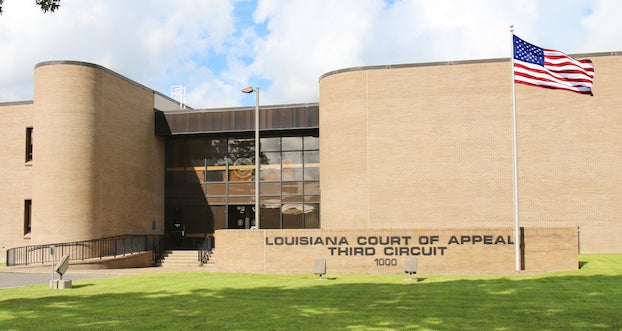Jeff Davis Parish jail undersized, outdated, always full
Published 3:24 am Sunday, May 12, 2013
JENNINGS — Officials in Jeff Davis Parish continue to work to find ways to build and operate a new parish jail to ease overcrowding and safety concerns caused by an aging facility.
“I don’t know what the answer will be if we don’t get a new jail,” Police Jury President Donald Woods said. “We have got to do something. We can’t keep turning these people loose because we don’t have the space. We keep arresting them and turning them loose, and they go back doing the same thing.”
The current 62-bed facility, built in 1964, is undersized, outdated, always filled to capacity and in need of replacement, Sheriff Ivy Woods said.
“For the amount of people we had in Jefferson Davis Parish then, I am sure 62 beds were adequate, but I’m not so sure of that anymore because we stay full,” he said.
“The numbers go down after court dates, but it is only a matter of hours before we are back up again.”
The jail, on the third floor of the parish courthouse in Jennings, has sewer problems, inadequate lighting, troublesome security and a less-than-ideal location, said Warden Dustin Locke.
Operating costs are skyrocketing as the 48-year-old facility deteriorates. It is in a constant need of repair, and jailers are put at risk by the confined space, poor lighting and lack of proper security, Locke said.
“There is only one way in and one way out, and once you open the (cell) door there’s only 3 feet of space between the officer and the wall,” he said.
Poor lighting also creates safety concerns in dark areas of the jail, Locke said. Other problems include issues with outdated plumbing, crumbling concrete along the bottom of jail cell bars, cracks in walls and floors, and flaking paint.
Locke is also concerned because fingerprinting for the public is done in the jail booking area.
Criminal cases
The lack of jail space has an astounding effect on criminal proceedings in 31st Judicial District Court, said District Attorney Michael Cassidy.
“We are constantly faced with the proposition of releasing less dangerous inmates in order to make room for those who pose the greatest risk to the public,” Cassidy said. “It is a weekly problem.”
At least two people per week have to be released because of the lack of space as judges, prosecutors and law enforcement officers are forced to determine who goes to jail and who is released, Cassidy said.
Most of those released face charges associated with burglary, drug possession, child support, worthless checks and other nonviolent offenses.
“Don’t get me wrong, they still face criminal charges, but they are released and free until their court date arrives,” Cassidy said. Those released are usually freed on a lower bond or on their own recognizance, he said.
Early releases present problems, Cassidy said.
“It is always easier to get an inmate to accept a plea agreement when they are already incarcerated,” he said. “When they are out free and we demand they give up their freedom, that’s hard to do.”
Citing an example of what the judicial system is faced with, Cassidy said the March 18 docket had 144 felony cases set for trial.
“We have seven weeks per year to have these jury trials,” Cassidy said. “If we tried every case, it would take almost 20 years at that rate — and that’s assuming all other crimes will stop.”
Plea agreements are a “necessary evil to the judicial system,” Cassidy said.
“We can solve cases by plea agreement and demand a person serve time, but it makes it more difficult if they are not currently incarcerated,” he said.
Outstanding warrants
The lack of jail space also affects outstanding warrants.
“We have close to 1,000 outstanding warrants. The vast majority are bench warrants where people who were supposed to come to court didn’t come as ordered,” Cassidy said. “Law enforcement is unable to go get those people unless we have somewhere to place them.”
The other outstanding warrants are for those accused of issuing worthless checks and minor property crimes.
A new jail with more space would help relieve the overcrowded docket, resolve cases more quickly and allow authorities to pick up people who have committed thefts and property crimes, Cassidy said.
Lack of jail space, overcrowded dockets and outstanding warrants are nothing unusual, he said. Most parishes are experiencing the same problems, he said.
The short-term solution would be to implement more substance abuse facilities since most crimes are associated with drug use and incarceration does not seem to cure the problem, Cassidy said.
Cassidy would also like to see more “day jail” facilities, where inmates spend their days behind fenced-in areas and return to their families at night.
Locke is concerned that the current facility can only hold four female inmates. Last year, nearly a dozen women were incarcerated at one time, presenting problems for the facility, he said.
He would like to see a new jail with more room for both female and male inmates.
A simple answer to the problem of overcrowding and safety concerns would be to expand the jail’s maximum inmate capacity to 200 to include women, men and juveniles whom the judge wants to try as adults. But officials say that comes with a huge price tag — $8 million to $10 million.
Jail consolidation
The Police Jury commissioned a study last year to consider the possibility of replacing the jail and consolidating the operations of municipal jails — in Jennings, Welsh and Lake Arthur — that now have a total capacity of 120 inmates in a centralized parish facility.
The study, by McNeese State University economics professor Michael M. Kurth and accounting professor Daryl V. Burkel, recommended the parish build an $8 million, 200-inmate jail with annual operating costs of $2.35 million.
The cost to operate the new facility would be $32.15 per inmate per day — $12.21 less than the $44.36 per day cost to run all four facilities independently.
The study listed the benefits of a new jail, including lower operating costs due to modern construction and new technology; savings associated with operating larger-sized facilities; reduced exposure to legal liability; more efficient operation for police and the courts; improved security; and expandable capacity.
“The Police Jury has done studies, and a good number for us is 200 inmates,” Ivy Woods said. “We don’t want to have too many.”
Plans for a new jail would include isolation space for sick and mentally disturbed inmates, including those on suicide watch, Ivy Woods said. The current jail uses the “drunk tank” to isolate inmates because of the lack of space, he said.
The new facility would also have video conference capability so that some inmates would appear for arraignments and other court dates via video link, reducing transport costs.
The cost of transporting prisoners to court and other jails and to receive medical care exceeded $23,780 in 2010 and 2011. That cost increased to $31,111 last year. More than $6,150 has already been spent to transport inmates this year.
A new facility would also have better on-site medical care for inmates — which could help lower the cost of inmate health care.
Cassidy said it has become a “very expensive thing” to run a jail properly, mainly because of inmate medical care.
The Police Jury and Sheriff’s Office are required by law to provide medical care for inmates, including taking them to a doctor’s office or other medical facility.
Medical care for inmates — doctor and emergency room visits, prescriptions, transportation — rose from $176,947 in 2010 to $251,919 in 2012, according to Police Jury assistant secretary-treasurer Renee Hicks. Medical costs amounted to $330,675 in 2011.
As of March 15, the Police Jury has spent $28,329 on medical care for inmates this year.
The cost to feed inmates has steadily increased from $69,604 in 2010 to $82,687 in 2011 and $84,199 last year. As of mid-March, $18,203 had so far been spent on feeding the inmates.
Jail locations
Among the sites being considered for the new jail is the former Southern Barbecue manufacturing facility on U.S. 90, just west of Jennings.
The location is ideal because it is in an industrial area with few residences in the immediate area, Ivy Woods said. The proximity to the courthouse, hospital and Interstate 10 add to its appeal, he said.
“I think it is a great location, and the facility is close to the Jennings infrastructure so water and sewage will be available,” Ivy Woods said.
Some 23 acres would be available on-site with ability to grow in the future, he said. A warehouse and office facility are already there.
An old warehouse on U.S. 90 just east of Jennings has also been considered, but officials think the site may not be large enough.
The Police Jury has secured $10 million from the state’s proposed capital outlay budget for planning and construction of the facility, but a sales tax, millage or combination of both would be needed for maintenance, Donald Woods said.
Deterring crime
Ivy Woods said a new jail would help deter crime and serve the parish’s needs for years to come.
“Hopefully we won’t have to build another one anytime soon,” he said. “Once we start putting people in jail the crime tends to go down because they know they are going to jail and it’s not as easy to get out.”
Proposals for a new jail have failed in the past, but Ivy Woods is optimistic the public will support the idea this time.
“I haven’t gotten much opposition about it,” Ivy Woods said. “Most people are concerned. They are tired of seeing these people out as well. They break into your home, take your stuff and the next week they are out on the street. They are not happy about that.”
Chief Criminal Investigator Christopher Ivey was part of a special state police task force assigned to Jennings in 2010, and saw the effect of the lack of jail space firsthand.
“We arrested more than 80 people in three months, but as soon as we picked them up we had to let them go because we didn’t have the jail space,” he said. “The criminals were not scared of the police anymore because they knew they would be out in a day or two because we didn’t have the facilities to hold them.”
Maintenance costs
Relocating the jail from the courthouse to another area would also lower security risk and reduce maintenance costs, Cassidy said.
“Our jail is old, and it has become an expensive place to maintain properly,” he said.
The cost to repair the jail — including plumbing and electrical work — have remained relatively steady at $14,000 in the last three years, according to the Police Jury. More than $3,500 was been spent on repairs for the first three months of 2013. Utilities cost $48,144 in 2010, $45,044 in 2011 and $45,000 in 2012. This year, utilities have cost the Police Jury more than $11,500.
The parish would save more than $248,000 a year just from consolidating all four jails in the parish and eliminating duplication of costs for record keeping and inmate processing alone, according to the study.
From a safety standpoint, relocating the jail would help lessen the potential for liability problems.
“It was built in the 1960s, and they placed it on the third floor of the courthouse,” Cassidy said. “In hindsight that was not a good idea because the inmates become disruptive by making noises or stuffing items in the plumbing that cause leaks on the second floor.”
Moving the jail out of the courthouse would also free up office and storage space for other agencies — including the clerk of court, Sheriff’s Office and district attorney — that contend with cramped quarters at the courthouse.
Failed past attempts
Twice in the last 15 years, Jeff Davis Parish voters have quashed plans to build a new jail. In May 2009, they overwhelmingly rejected a sales tax increase for a $12 million parish jail and sheriff’s administration office.
The tax would have generated $1.1 million a year to build and maintain a 22,000-square-foot facility just east of the parish courthouse in Jennings.
Preliminary plans for the facility would have increased inmate capacity from 66 to 228 and included a medical isolation unit. Remaining space would have been used for administrative offices and a new 911 command center.
The project would have been funded by a 40-year, low-interest loan from the U.S. Department of Agriculture’s Rural Development Office.
In July 1998, voters defeated a half-cent sales tax that would have funded construction of a jail and would have paid for Sheriff’s Office salaries.
A photo of the inside of a four-man Department of Corrections jail cell shows the overcrowded conditions of the Jefferson Davis Parish Jail in Jennings. The current jail is an outdated structure with sewer problems




